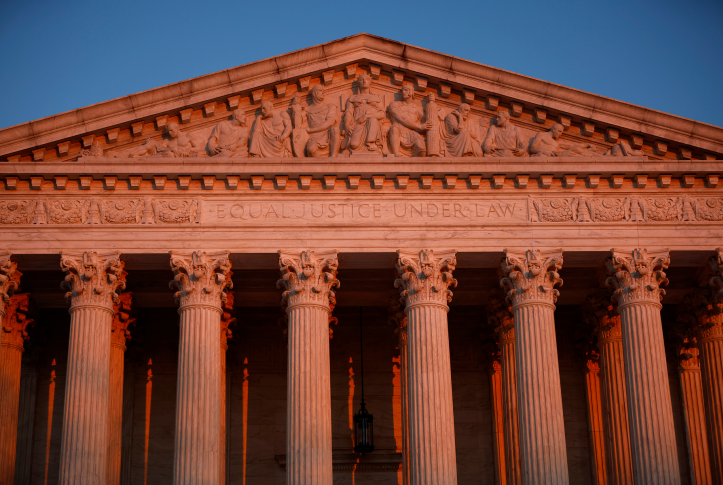Having access to the courts when your rights are violated is a fundamental tenet of American law. For more than 50 years, Medicaid beneficiaries and providers have been able to seek protection from the federal courts when state officials violate their coverage and payment rights. But the Supreme Court is now poised to decide whether this vital protection will survive or if states may take unlawful actions without fear of direct and immediate judicial accountability. As part of its Medicaid oversight, the U.S. Department of Health and Human Services (HHS) can step in to remedy violations of law, but the enforcement process is long and arduous, beneficiaries have no ability to seek HHS help, and HHS can choose whether to intervene.
The upcoming case, Health and Hospital Corporation of Marion County v. Talevski, will be argued on November 8. The rights immediately at stake concern protections guaranteed by Medicaid’s Federal Nursing Home Reform Act that the defendants (a public nursing home) are alleged to have violated as a result of grievously negligent treatment. The right to access the court comes from section 1983 of the Civil Rights Act of 1871, which grants people the ability to turn to the federal courts when states violate rights guaranteed by law, including the right to Medicaid services. Without section 1983, beneficiaries and providers have nowhere to turn when they believe their rights have been violated. In Talevski, the Court has decided to more broadly consider whether section 1983’s right of access to federal courts will remain for beneficiaries and providers who claim that state officials have violated rights guaranteed under Medicaid, and not just for Medicaid nursing homes.
The Court could agree with Indiana officials and hold that laws enacted by Congress pursuant to its Spending Clause powers and administered by states — such as Medicaid — are not the types of laws that Congress had in mind when it enacted section 1983. Were the Court to adopt the state’s position, it would essentially conclude — contrary to the plain language of section 1983 — that such programs are agreements between governments and do not create enforceable rights within the meaning of 1983. Such a ruling would abandon a half-century of Supreme Court precedent and implicate the entire constellation of state-administered public welfare programs, including Supplemental Nutrition Assistance Program (SNAP, formerly known as food stamps), child welfare, and federal public housing benefits.
In an amicus brief in support of the Talevski family, former HHS officials explain that when rights are violated, HHS has limited tools. It can try to persuade state officials to agree to address the problem, but it cannot do what a court does: immediately order state officials to stop violating the law. Ultimately officials can withdraw federal funding if negotiation fails, but states can appeal, and this process can take years. In other words, HHS’ powers are not designed to achieve rapid, targeted solutions. HHS can try to negotiate a resolution, as is the case in Missouri, where state officials stopped processing Medicaid applications, thus stripping people of the right to apply for benefits. But HHS intervenes at its own discretion; even when rights are being violated, federal law offers beneficiaries and providers no pathway to seek the agency’s help and intervention — only the courts have this power.
Talevski carries enormous implications for beneficiaries and providers, especially safety-net providers that serve large numbers of low-income and medically vulnerable people who rely on Medicaid. When patients lose or are denied coverage, these providers will lose an important source of income. Safety-net patients placed in this predicament are likely to remain completely uninsured.
The Medicaid beneficiary guarantees most threatened are the right to apply for assistance, the rights to prompt assistance if eligible, and the right to comprehensive coverage, including benefits available through Medicaid’s Early and Periodic Screening, Diagnostic, and Treatment (EPSDT) program for children. For safety-net providers, the right to payment at rates set by Congress would be affected.
Without section 1983, a state could try — and several have already done — to strip Medicaid beneficiaries of their right to select the qualified family planning provider of their choice by excluding certain providers from program participation; for instance, denying program participation status to providers that, in addition to furnishing Medicaid-covered family planning services, also provide abortions. Numerous courts have barred states from pursuing such policies. Without section 1983, the right to stop such unlawful exclusions would be lost; in the past, HHS has shown only modest appetite for intervening.
Some providers will experience a direct impact. Federally qualified health center services are a mandatory Medicaid service — states must cover and pay for these services. Furthermore, payment must reflect the reasonable cost of care. This means that states cannot force community health centers (CHCs) to rely on limited grant funds meant for uninsured patients as a way of offsetting Medicaid shortfalls. Over the years, states have attempted to restrict payment on federally qualified health center services or have tried to pay less than what they owe. HHS has generally failed to intervene. The courts have recognized CHCs’ ability to use section 1983 to avert loss of revenue and secure payments owed. In their amicus brief on behalf of the Talevski family, CHCs present evidence of the impact of withdrawing section 1983 rights. Based on the amount of funding typically at issue in payment disputes, single-year payment losses could exceed $640 million nationwide. This could translate into lost patient capacity of 500,000 to more than 3 million patients in a single year, as well as thousands of staffing reductions.
If the Court decides to strip beneficiaries and providers of their section 1983 enforcement rights, it would effectively reject a half-century of direct Supreme Court precedent. Despite its profound nature, the case deals with especially technical questions, meaning that the Court could issue its decision quickly and without the type of fanfare that accompanies better-known cases held to the end of the term (e.g., Dobbs v. Jackson Women’s Health Organization). We may not need to wait until June 2023 to learn the fate of Medicaid as a legally enforceable right.




